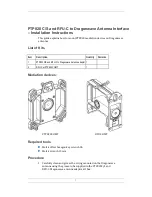
Manual Version:5PW100-20120627
3
Safety precautions
WARNING!
•
Installing antennas is dangerous. For your safety, follow the installation directions.
•
Keep the antenna away from power source, street lamps, distribution box, or other places that may
cause electrical shock.
•
Do not touch any power lines for your safety.
•
Keep safety in mind when you select your installation site. Keep the antenna away from electric
power lines and other lines.
•
Do not work alone when you install the antenna.
•
If you need to raise the mast, work with other people to avoid bodily injury.
•
Do not use a metal ladder. Do not work on a wet or windy day. Dress properly, for example, shoes
with rubber soles. Wear rubber gloves.
•
If the antenna, antenna cable, or any other installation accessory drops, get away from it to avoid
bodily injury.
•
If an accident, for example, electrical shock, occurs with the power lines, immediately call for
qualified emergency help.
Installation guidelines
Keep the antenna away from metal obstructions such as heating and air-conditioning ducts. Typically, the
higher an antenna is above the ground, the better it performs. If possible, use a cable as short as possible
to connect the antenna and AP.
Mounting the antenna
You can mount the ANT-2003CM antenna on a ceiling or on a wall. The installation accessories are
provided (installation tools are user supplied). If you intend to mount your antenna on another surface,
you must provide the appropriate installation accessories.
Tools and accessories required
•
Accessories provided with the antenna:
{
Two wall anchors
{
Two screws
{
Two curved spring washers
{
One cable
{
Two bolts
•
User-supplied tools:
{
One Phillips screwdriver
{
One electric drill and associated drill bits
{
One pencil

























